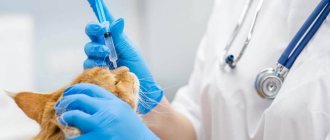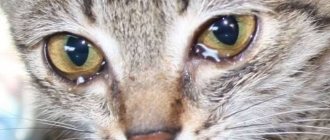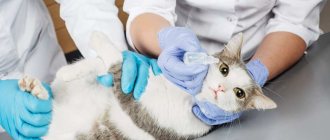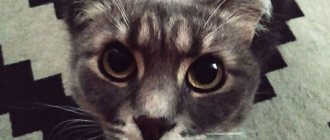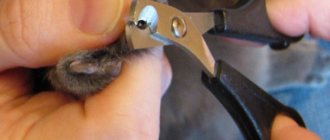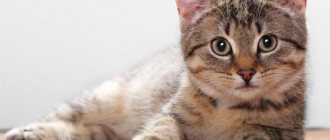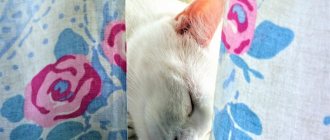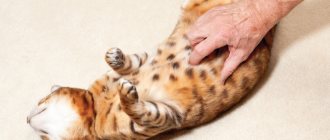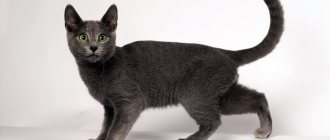There are all sorts of situations, and it’s better to find out in advance how to do it correctly and what means you can use, than to rush around in a panic at a difficult moment.
Moreover, there is nothing complicated in this procedure and absolutely anyone can cope with it.
Causes and symptoms of eye diseases
Most often, an animal's eye waters for a trivial reason - a tiny speck has gotten into it and the cat's body is trying to remove it in this way. Most likely, you won’t have to intervene here: a few hours and the problem will be solved naturally.
But often the reasons are more serious. We list them below:
Injury (wound, scratch, cut) received during a fall, play or fight. The cornea turns red, the mucous membrane swells, and bleeding may occur.- If a foreign body gets into the eye, severe lacrimation will first occur, gradually the cornea and eyelid will turn red, and pus will appear.
- The cause of blepharitis (inflammation of the eyelids) is an untreated wound in the mucosal area that has become infected. This often happens to cats walking outside: if you scratch your eye with a dirty paw, a problem arises. The eyelids swell, cloudy mucus flows from the eye.
- Eversion or inversion of the eyelid, keratitis, conjunctivitis occurs with severe burns, due to the ingress of a foreign body or exposure to chemicals. The mucous membrane and cornea turn red, the cat hides from the light, tears flow from the eyes.
- Parasitosis is unexpected, but true: some types of parasites (Thelazia californiensis, Thelazia callipaeda) settle not only in the fur or intestines, but also in the eye area: between the eyelashes, under the eyelids, in the cornea itself. The first symptoms include conjunctivitis, itching, loss of eyelashes and hair around the eyes, clouding of the cornea, ulcers on the cornea, and fever. Only a specialist can remove worms and their larvae, and the owner can also wash the eyes with antibacterial drugs.
- In infectious diseases, the entire body may be affected (for example, chlamydia or plague) or the focus will be concentrated in the eye. Symptoms vary: lacrimation, the appearance of a tumor, crusts on the eyelids, etc.
- A cat may be allergic to: poplar fluff, perfume or household chemicals, pollen, etc. The eyelids turn red, clear, odorless mucus flows from the eyes.
- The anatomical features of some cat breeds (rexes, sphinxes) provoke health problems. This also applies to the eyes.
Treatment
To begin with, you should determine the nature of the discharge: whether it is purulent and whether there are accompanying symptoms. You should immediately take your pet to the veterinarian if:
- the occurrence of purulent discharge;
- refusal of water;
- temperature rise;
- the cat vomits foam;
- lack of appetite and lethargic behavior.
To reduce cat tearfulness, the following actions are taken:
It is necessary to regularly wipe your eyes with herbal decoctions or a mixture of boiled water and potassium permanganate or tea leaves. If the wool is light in color, then this procedure will turn it brown - this does not pose a danger. Tetracycline ointment is a universal antimicrobial drug. It is applied at night, spreading a small amount onto the eyelids. Use “Iris” eye drops: a couple of drops are dripped into each visual organ, and then the leaked residue is wiped dry
It is important to ensure that the cat does not start scratching them, otherwise irritation will begin.
Before using ointments and drops, you should first consult with your veterinarian so as not to aggravate the disease with incorrectly selected treatment.
Cautions
If the disease is serious, you cannot do without consulting a veterinarian. Only a specialist can prescribe appropriate medications and procedures based on your medical history and test results.
Otherwise - if street dust gets into the cat's eyes, for example - you can do a simple cleansing yourself. But remember a few important rules:
Not all water can be used for this.
There is definitely no tap water - the bleach and salts contained in it dry out the mucous membrane and destroy the natural microflora. In addition, such water may be contaminated. Rain and melt water are also not suitable. The liquid must be boiled and cooled!- Instead of cotton wool, use cotton pads: this is the only way to be sure that small fibers will not get under the eyelid and cause additional problems.
- For each eye - a new tampon, for each procedure - a fresh decoction.
- You cannot use chamomile infusion - it causes cats to lose hair.
- Rinse solutions should be warm, not hot or cold.
- If days go by and there is still no result, take your cat to the doctor.
Prevention
To prevent such a situation, preventive measures are taken:
- The animal is kept in a clean room.
- If a kitten gets dirty, it must be washed.
- Be sure to wash the tray, since dirt accumulated there can cause various problems.
- If an animal is walking outside, it is carefully examined after returning home.
- It is recommended to prevent contact with street animals.
When souring occurs, it is necessary to determine the cause and take appropriate measures. Remember that only a veterinarian can make the correct diagnosis and prescribe treatment. Don't forget to maintain good ear hygiene.
How to wash a cat's eyes?
If, after reading the title, you imagined expensive drugs - exhale, calm down and look in your home medicine cabinet. We assure you: you can always find something suitable there.
Medicines
Of the human medicines for washing cat eyes, you can use:
- isotonic solution 0.9% (saline) - is one of the most important components of tissue fluid and plasma, due to which it does not irritate the skin and mucous membranes of animals;
- Furacilin solution (0.02%) - is an antibacterial drug for external use (you can buy tablets and prepare the solution yourself);
- boric acid solution - dissolve 1 small spoon of powder in a glass of warm water;
- chlorhexidine (it is better to take a concentration of 0.01%) - a cheap product with a good bactericidal effect;
- potassium permanganate solution (1:5000).
The list is small, but it is not recommended to use other drugs without a veterinarian’s prescription: problems with intolerance or dosage calculation may arise.
Stick to dosages strictly! The slightest mistake can lead to irreversible consequences: severe chemical burns and even blindness. If your animal develops allergy symptoms, stop using the product immediately and show the animal to a doctor!
Pet stores sell special products for cats:
Diamond Eyes drops are antibacterial drops for topical use.
Relieves swelling and inflammation, destroys bacteria. Contains: succinic acid, taurine, chlorhexidine bigluconate, purified water. Contraindications: individual intolerance. Compatible with other medications.- Drops "Bars" - contain nitrofural and chloramphenicol. They have a bactericidal and bacteriostatic effect, cope with certain types of viruses, and relieve pain. Contraindications: allergy to components.
- Drops "Iris" - an analogue of "Bars". Gentamicin sulfate (base) has a pronounced bactericidal effect.
- OPHTO-LAVAS is a sterile eye cleansing solution. Do not allow the drug to come into contact with the skin of the animal.
Folk remedies
It is not always possible to find a suitable drug in a home medicine cabinet. In such a situation, you can use time-tested folk methods. Here are some examples:
- Lime tea. Pour 75 ml of boiling water over a small amount of linden flowers, let it brew for half an hour, filter with gauze and rinse the animal’s eyes.
- Elderberry leaves. Grind 10 g of elderberry leaves, pour boiling water over it, cover with a lid and leave in a saucepan for 40 minutes. The resulting liquid can be used to wash your eyes 3-6 times a day.
- Infusion of celandine. Helps with excessive purulent discharge from the eyes, pain and redness. Finely chop a few fresh celandine leaves (4-6), brew 5 ml of boiling water and leave for 15 to 25 minutes. Place the infusion in your eyes (and in healthy eyes too).
- Black tea. You can only use yesterday's tea leaves, which have been brewed for 10-12 hours. Soak cotton pads in the liquid and apply to the cat's eyelids for a few seconds. At least six such procedures must be performed per day. Sugar or other sweeteners must not be added!
- Decoction of chamomile, St. John's wort, hyssop. If your cat's eyelids stick together, prepare a decoction of 1 tablespoon of any herb and a glass of boiling water, let it brew for 10 minutes, strain, moisten a piece of gauze and wash the animal's eyes 2-3 times a day.
- Aloe. Not the pulp, but aloe juice removes pus and relieves inflammation. Grind 2-3 leaves in a blender into porridge, strain the juice. Instill 1 drop 2 times a day: morning and evening.
- Yarrow decoction. Pour 10 g of the collection with a glass of boiling water, leave for half an hour, strain and rinse the mucous membranes of the eyes 2-4 times a day.
How to properly care for a British breed kitten?
Like any small kitten, a change of place of residence entails stress. The animal needs some time to get used to its new family, environment and established rules of behavior.
Ear cleaning
Initially, it is necessary to monitor the condition of the ears, fur, eyes and teeth. Based on the state of these indicators in an animal, we can talk about the general health of the pet.
The kitten is not yet able to fully ensure proper hygiene for some time. This applies especially to his ears. Therefore, a good owner should regularly monitor the condition of the animal’s ear and, if necessary, clean it.
To prevent the kitten from getting scared and stressed during this unpleasant procedure, it is recommended to clean its ears when the baby is fast asleep. This must be done carefully, because when the kitten wakes up, it may become even more frightened when it discovers that they are trying to do something to it.
Also, to prevent the animal from injuring itself or you during this procedure, it can be wrapped in a soft towel. The cleaning procedure should be carried out regularly, accustoming the animal to it from an early age so that it gets used to it and is not afraid.
Experts advise cleaning your British kitten's ears once a month. You shouldn’t do it too often or, on the contrary, forget about your pet’s health. Ideally, you should constantly monitor the level of dirt in your kitten's ears and clean them as needed.
Cotton pads are perfect for caring for your animal's ears; you can apply special soap or shampoo purchased at a pet store to them.
Hygiene products designed specifically for these purposes will provide comfortable and safe care for your pet. It is not recommended to use ear sticks. They can injure your pet if it moves accidentally.
If dark dots or drops of blood are found in the ears, you should urgently contact a veterinarian. Such symptoms may be associated with parasitic ear mites, which an experienced veterinarian will help remove.
Grooming
It is also necessary to monitor the condition of the kitten’s coat. Until 3 months of age, British kittens have not yet learned to carefully care for their fur, and the very idea of caring for their fur is of little interest to them during this period.
Therefore, regular care of the coat and undercoat is mandatory.
We also shouldn’t forget about bathing the kitten. Pay special attention to the condition of the kitten's fur after he goes to the toilet. If necessary, remove contamination immediately.
When a British breed kitten reaches 3 months, he will begin to independently show interest in his own hygiene - he will begin to lick his fur, wash his paws and face. But this does not mean that the animal does not need observation; it is simply possible to check the external condition of the pet less often.
Eye care
The eyes of British breed cats can often become watery. This feature is especially evident in small kittens. To protect the animal from possible complications and bleating, it is necessary to use cotton pads to remove excess mucus or dust from the pet’s eyes.
To prevent eye diseases in cats, it is recommended to moisten cotton pads with tea or chamomile tincture. Cleaning should be done carefully, starting from the outside and gradually moving towards the inside of the eye.
If the animal has purulent discharge near the eyes, or the cat often scratches its face, you need to contact a veterinarian.
Timely diagnosis and properly prescribed treatment will help avoid health problems.
Teeth cleaning
Brushing your teeth also needs to be given due attention. It needs to be done regularly, even if cats don’t particularly like it. In order for the animal not to resist this procedure so much in the future, it is necessary to accustom it to it from an early age.
When brushing your teeth, pay attention to the condition of your gums. When healthy, they are light pink in color. If you find red spots or other abnormalities on your gums, you should contact your veterinarian.
Proper nutrition
A proper diet is an essential part of your pet’s healthy lifestyle. A balanced diet will help your cat grow up healthy and strong. To do this, the owner must ensure that the cat receives all the necessary vitamins and microelements from its food.
There are also various nutritional supplements that may contain certain vitamins. If possible, you should consult a specialist veterinarian who will tell you what supplements you can give your pet and how to properly balance its diet.
Nail trimming
An animal's claws can also tell a lot about the animal's health. The claws must be hard and durable. Brittle claws and excessive separation may indicate a lack of vitamins.
Talk to your veterinarian about this; he will recommend a drug that will return your pet’s claws to a healthy state.
Claws need to be trimmed regularly.
Special scissors for these purposes can be purchased at a pet store. You need to trim the claws carefully, because you can cut off too much and hurt the capillary.
To prevent the trimmed claw from clinging and creating discomfort for the animal, it is recommended to treat it with a special nail file.
And remember, if you decide to get yourself a cat, you must be aware that along with the animal you also acquire responsibility for it.
Keep an eye on your pet and carry out all the necessary procedures. If suddenly you begin to notice that something wrong is happening to your pet, that his health condition has worsened, you don’t know what to do, don’t hesitate and contact a veterinarian as soon as possible.
It is an experienced veterinarian who will be able to tell you what is best to do with your pet in a particular case. It is not advisable to treat serious problems in a cat on your own. The health of your cat primarily depends on your attention.
Features of the procedure
Whether a cat requires treatment or a kitten, there are no significant differences in treatment procedures.
In both the first and second cases, accuracy and calm are required. Animals, not understanding what is happening to them, begin to get nervous, fidget and may even try to bite.
To make the process safer, you can use a special bag-retainer (these are sold in pet stores), or an ordinary thick blanket in which you can wrap the cat, leaving only its head free.
Materials you will need:
- sterile gauze or cotton pads;
- clean towel or cloth napkins;
- syringe or pipette;
- the drug itself.
In adults
- It will be great if you involve an assistant in the matter. He will be able to fix the animal in the desired position, and you will calmly and without distraction carry out all the necessary manipulations. The animal is placed in a retaining bag or wrapped in a blanket, hiding its paws and claws away.
- Wash your hands thoroughly with soap.
- Dry crusts in the corners of the eyes or on the eyelids should never be peeled off - only soaked and carefully peeled off little by little. Ordinary clean water will help soften them: moisten a cotton swab generously, press it to the eye and hold, and when the crusts become noticeably softer, slowly peel them off. Do not pour water into your cat's eyes unnecessarily, do not rub the cornea, and follow a line from the ears to the nose along the tear duct. Use a separate clean pad for each eye.
- If during rinsing you notice foreign, indelible particles lying on the surface of the eye or in the folds of the conjunctiva, do not touch them and do not try to remove them yourself, immediately run to the doctor!
- Are your eyes clear? Excellent: you can wash it with medicine. To do this, use either a regular human pipette, a syringe, or a 20 ml syringe (without a needle, of course). Spread the eyelids with two fingers (index and thumb) and drip the solution into the upper outer corner of the eye: this way the solution will thoroughly wash the entire cornea and conjunctival sac. The remaining solution is blotted with a napkin or towel.
Do not rub the cornea with a cloth, do not press on it - this can cause grass to the animal.
In kittens
Unlike adults, kittens cannot perform a full toilet until a certain age: their mother cat takes care of them for a long time and the babies need time to get used to doing everything on their own.
Therefore, if problems begin with the kittens’ eyes, and the mother cat is not nearby, you will have to deal with it yourself. Proceed in the same way as with adult animals. But even more care and attention is needed, because kittens’ eyes are smaller and more vulnerable than those of adults.
You don’t need to involve an assistant here: you can handle the baby yourself. The most convenient time is after sleep, when the baby has not yet played out, or before bed. You cannot carry out the procedure immediately after eating - the kitten may vomit.
If, in addition to cleansing rinses, you will also need to apply ointments, wait 10 minutes after the procedure. This minimizes the risk of mucosal irritation.
If you have never washed your animal’s eyes and, in general, be afraid to carry out any medical procedures - contact your nearest veterinary clinic. They will take a little money for this, but they will do everything quickly and carefully, and they will also give useful advice for the future.
Chemistry against panic
In cases where a pet has encountered chemicals, it is important to find out what exactly it was stained with. And then choose what to wash the kitten’s eyes with:
- Before rinsing your eye, make sure that the solution you choose does not react violently with the chemical agent;
IMPORTANT! Trying to immediately neutralize a substance is dangerous. The reaction can be violent and can further damage vision. For a short time after the chemical gets into the eye, it will be contained by the mucous membrane.
- First, rinse your eyes with water; A warm (about 35 degrees) shower or water fountain for rinsing should be “soft”;
- After washing, it will be necessary to neutralize the remaining aggressive substance. Let someone help you save time while you prepare the neutralizing solution.
- It takes 10-15 minutes to rinse the cat's eyes from chemicals with clean running water. The eyelids should be wide open (you will have to help the animal, even if it resists).
ADVICE! Almost all synthetic cleaners and detergents are slightly acidic, while natural soaps are alkaline.
Acids
After a water shower, continue to rinse with a 2% sodium bicarbonate solution (can be purchased at a pharmacy). If the pain bothers your pet too much, instilling a drop of novocaine solution (1%, for the eyes) is acceptable.
Alkalis
Alkali is quite difficult to remove from the mucous membrane. After a ten-minute rinse with water, at least half an hour of neutralization with isotonic sodium chloride (saline solution for injection) will be required. And then a 1% aqueous solution of ascorbic acid will not be amiss.
